Change Management Report: Sydney Media Agency Case Study, Feb 2018
VerifiedAdded on 2020/05/28
|10
|2798
|125
Report
AI Summary
This report analyzes a change management issue within a Sydney-based media agency, where a new policy prohibited employees from taking company laptops home. The report, submitted by a student, examines the adverse impacts of this sudden change on employee satisfaction and performance, highlighting communication issues and the lack of employee participation in the decision-making process. It explores the social construction model of communication and the importance of effective leadership in managing organizational change. The report provides recommendations for improvement, emphasizing the need for transparent communication, employee involvement, sufficient time for adaptation, and strong leadership at all levels to address employee grievances and facilitate a smoother transition. The report concludes that a well-managed change process is essential for maintaining both organizational growth and employee well-being.
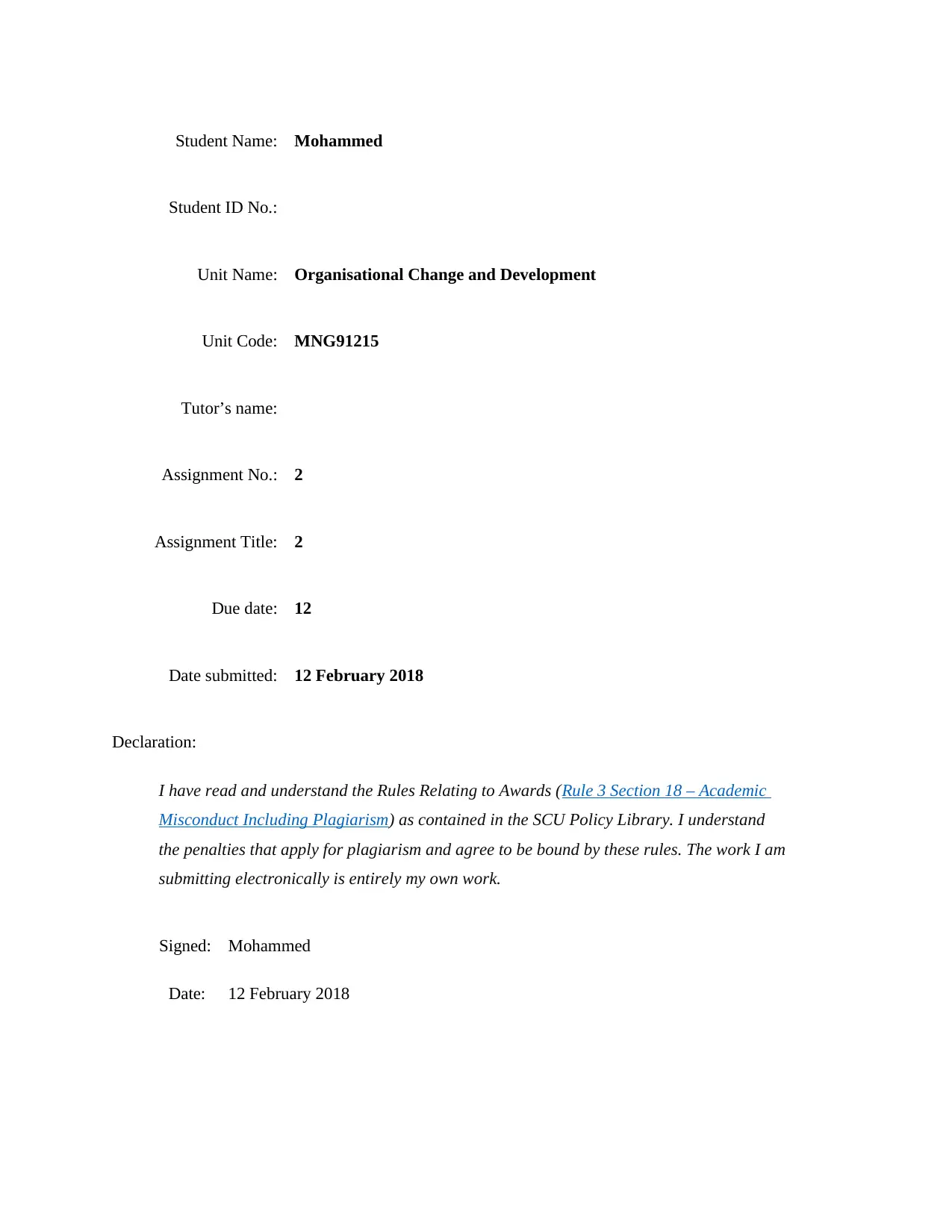
Student Name: Mohammed
Student ID No.:
Unit Name: Organisational Change and Development
Unit Code: MNG91215
Tutor’s name:
Assignment No.: 2
Assignment Title: 2
Due date: 12
Date submitted: 12 February 2018
Declaration:
I have read and understand the Rules Relating to Awards (Rule 3 Section 18 – Academic
Misconduct Including Plagiarism) as contained in the SCU Policy Library. I understand
the penalties that apply for plagiarism and agree to be bound by these rules. The work I am
submitting electronically is entirely my own work.
Signed: Mohammed
Date: 12 February 2018
Student ID No.:
Unit Name: Organisational Change and Development
Unit Code: MNG91215
Tutor’s name:
Assignment No.: 2
Assignment Title: 2
Due date: 12
Date submitted: 12 February 2018
Declaration:
I have read and understand the Rules Relating to Awards (Rule 3 Section 18 – Academic
Misconduct Including Plagiarism) as contained in the SCU Policy Library. I understand
the penalties that apply for plagiarism and agree to be bound by these rules. The work I am
submitting electronically is entirely my own work.
Signed: Mohammed
Date: 12 February 2018
Paraphrase This Document
Need a fresh take? Get an instant paraphrase of this document with our AI Paraphraser
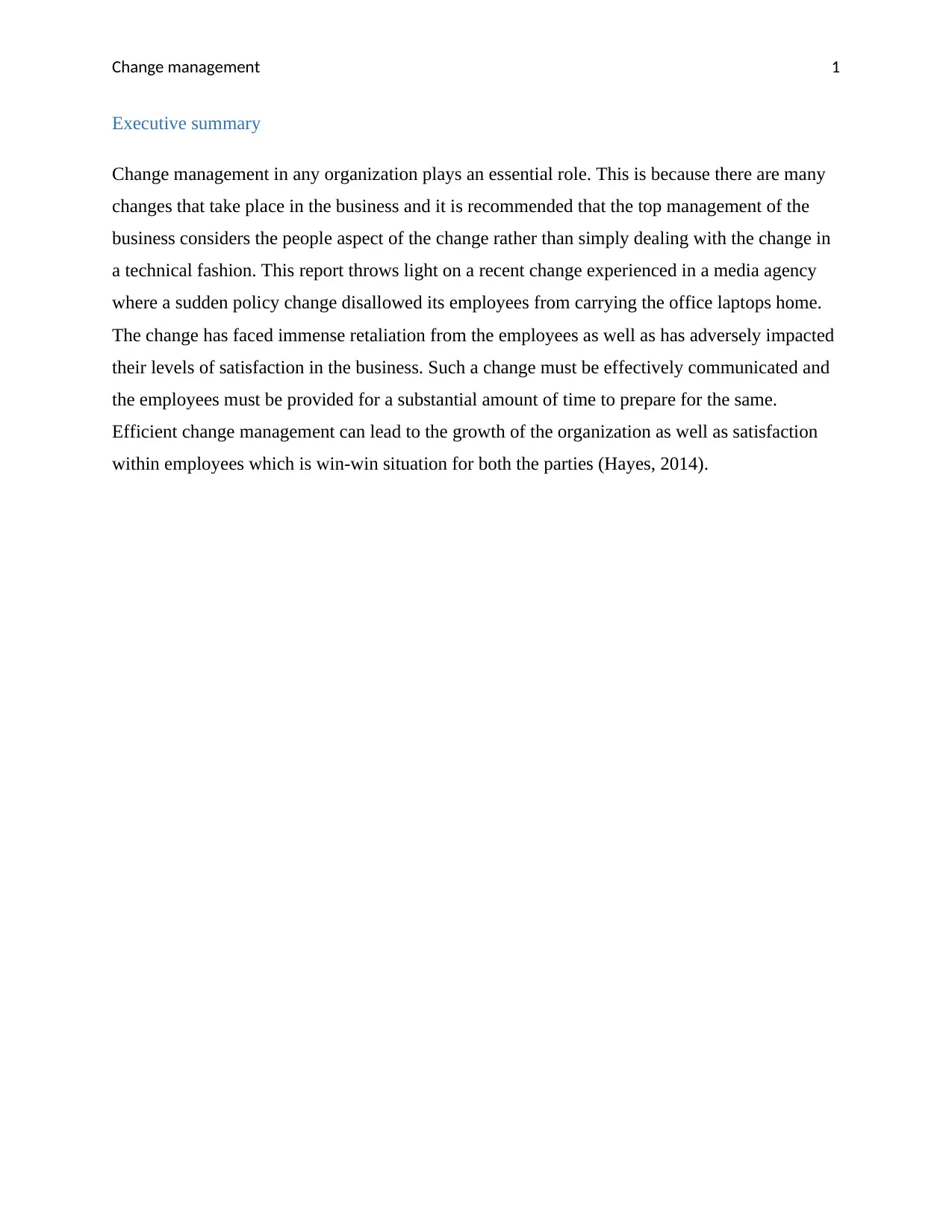
Change management 1
Executive summary
Change management in any organization plays an essential role. This is because there are many
changes that take place in the business and it is recommended that the top management of the
business considers the people aspect of the change rather than simply dealing with the change in
a technical fashion. This report throws light on a recent change experienced in a media agency
where a sudden policy change disallowed its employees from carrying the office laptops home.
The change has faced immense retaliation from the employees as well as has adversely impacted
their levels of satisfaction in the business. Such a change must be effectively communicated and
the employees must be provided for a substantial amount of time to prepare for the same.
Efficient change management can lead to the growth of the organization as well as satisfaction
within employees which is win-win situation for both the parties (Hayes, 2014).
Executive summary
Change management in any organization plays an essential role. This is because there are many
changes that take place in the business and it is recommended that the top management of the
business considers the people aspect of the change rather than simply dealing with the change in
a technical fashion. This report throws light on a recent change experienced in a media agency
where a sudden policy change disallowed its employees from carrying the office laptops home.
The change has faced immense retaliation from the employees as well as has adversely impacted
their levels of satisfaction in the business. Such a change must be effectively communicated and
the employees must be provided for a substantial amount of time to prepare for the same.
Efficient change management can lead to the growth of the organization as well as satisfaction
within employees which is win-win situation for both the parties (Hayes, 2014).
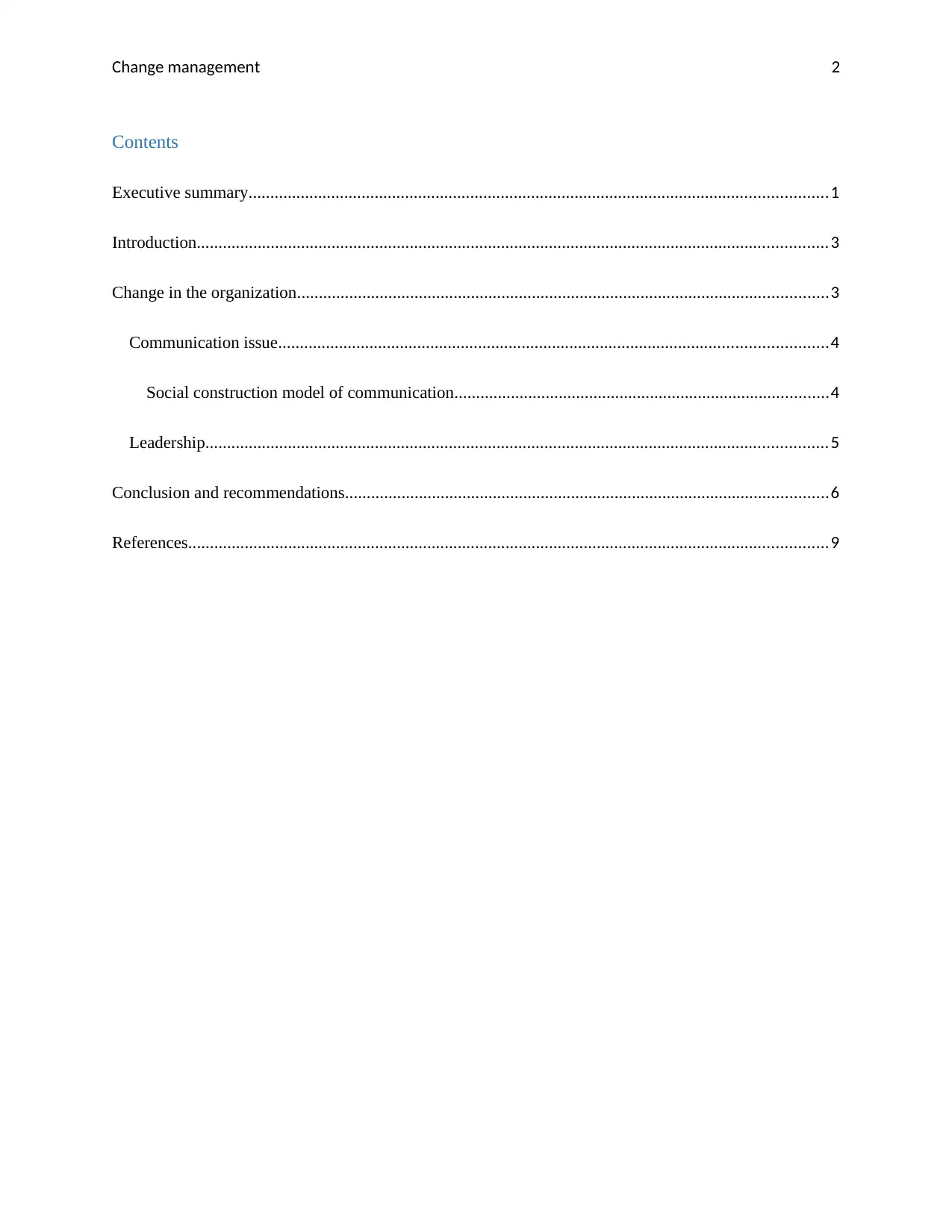
Change management 2
Contents
Executive summary.....................................................................................................................................1
Introduction.................................................................................................................................................3
Change in the organization..........................................................................................................................3
Communication issue..............................................................................................................................4
Social construction model of communication......................................................................................4
Leadership...............................................................................................................................................5
Conclusion and recommendations...............................................................................................................6
References...................................................................................................................................................9
Contents
Executive summary.....................................................................................................................................1
Introduction.................................................................................................................................................3
Change in the organization..........................................................................................................................3
Communication issue..............................................................................................................................4
Social construction model of communication......................................................................................4
Leadership...............................................................................................................................................5
Conclusion and recommendations...............................................................................................................6
References...................................................................................................................................................9
⊘ This is a preview!⊘
Do you want full access?
Subscribe today to unlock all pages.

Trusted by 1+ million students worldwide
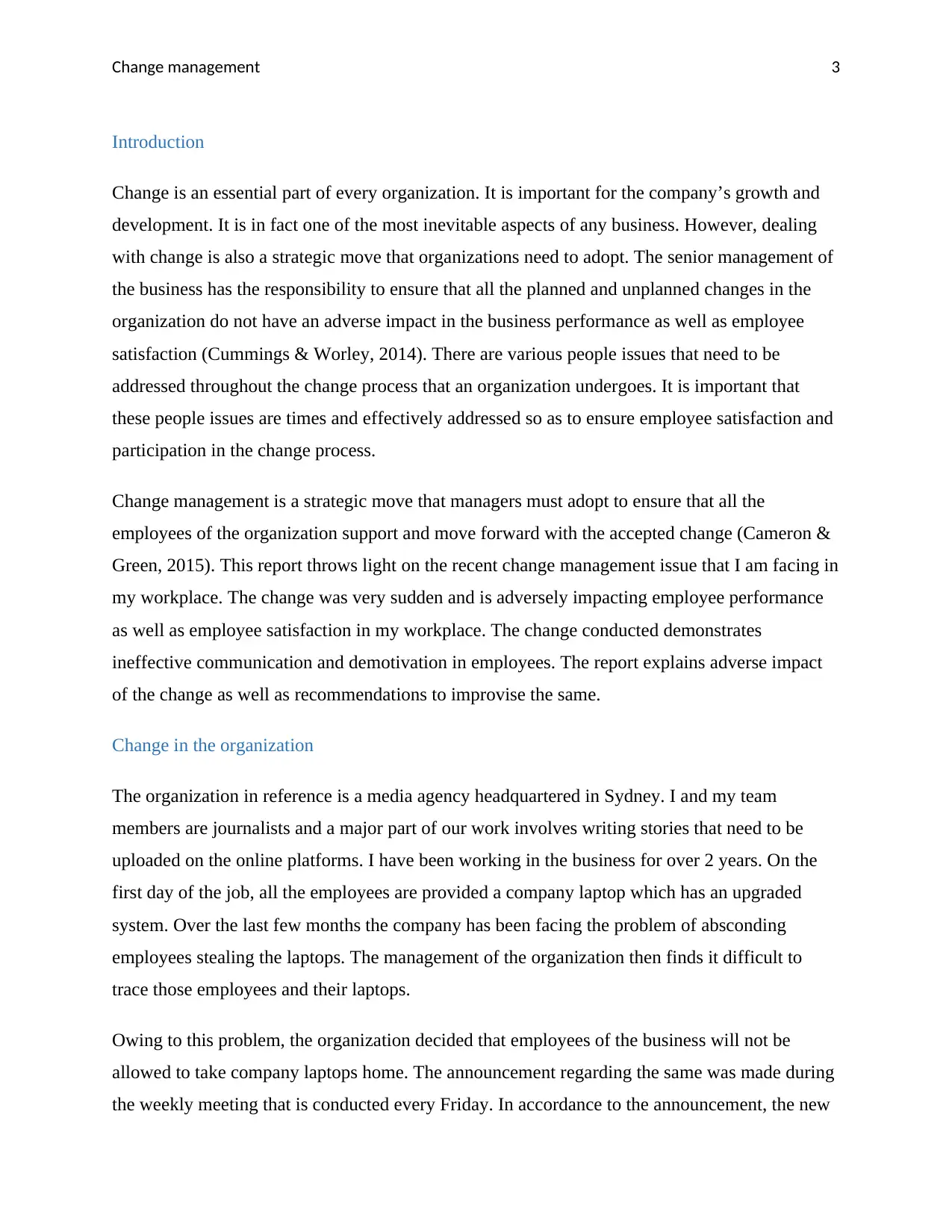
Change management 3
Introduction
Change is an essential part of every organization. It is important for the company’s growth and
development. It is in fact one of the most inevitable aspects of any business. However, dealing
with change is also a strategic move that organizations need to adopt. The senior management of
the business has the responsibility to ensure that all the planned and unplanned changes in the
organization do not have an adverse impact in the business performance as well as employee
satisfaction (Cummings & Worley, 2014). There are various people issues that need to be
addressed throughout the change process that an organization undergoes. It is important that
these people issues are times and effectively addressed so as to ensure employee satisfaction and
participation in the change process.
Change management is a strategic move that managers must adopt to ensure that all the
employees of the organization support and move forward with the accepted change (Cameron &
Green, 2015). This report throws light on the recent change management issue that I am facing in
my workplace. The change was very sudden and is adversely impacting employee performance
as well as employee satisfaction in my workplace. The change conducted demonstrates
ineffective communication and demotivation in employees. The report explains adverse impact
of the change as well as recommendations to improvise the same.
Change in the organization
The organization in reference is a media agency headquartered in Sydney. I and my team
members are journalists and a major part of our work involves writing stories that need to be
uploaded on the online platforms. I have been working in the business for over 2 years. On the
first day of the job, all the employees are provided a company laptop which has an upgraded
system. Over the last few months the company has been facing the problem of absconding
employees stealing the laptops. The management of the organization then finds it difficult to
trace those employees and their laptops.
Owing to this problem, the organization decided that employees of the business will not be
allowed to take company laptops home. The announcement regarding the same was made during
the weekly meeting that is conducted every Friday. In accordance to the announcement, the new
Introduction
Change is an essential part of every organization. It is important for the company’s growth and
development. It is in fact one of the most inevitable aspects of any business. However, dealing
with change is also a strategic move that organizations need to adopt. The senior management of
the business has the responsibility to ensure that all the planned and unplanned changes in the
organization do not have an adverse impact in the business performance as well as employee
satisfaction (Cummings & Worley, 2014). There are various people issues that need to be
addressed throughout the change process that an organization undergoes. It is important that
these people issues are times and effectively addressed so as to ensure employee satisfaction and
participation in the change process.
Change management is a strategic move that managers must adopt to ensure that all the
employees of the organization support and move forward with the accepted change (Cameron &
Green, 2015). This report throws light on the recent change management issue that I am facing in
my workplace. The change was very sudden and is adversely impacting employee performance
as well as employee satisfaction in my workplace. The change conducted demonstrates
ineffective communication and demotivation in employees. The report explains adverse impact
of the change as well as recommendations to improvise the same.
Change in the organization
The organization in reference is a media agency headquartered in Sydney. I and my team
members are journalists and a major part of our work involves writing stories that need to be
uploaded on the online platforms. I have been working in the business for over 2 years. On the
first day of the job, all the employees are provided a company laptop which has an upgraded
system. Over the last few months the company has been facing the problem of absconding
employees stealing the laptops. The management of the organization then finds it difficult to
trace those employees and their laptops.
Owing to this problem, the organization decided that employees of the business will not be
allowed to take company laptops home. The announcement regarding the same was made during
the weekly meeting that is conducted every Friday. In accordance to the announcement, the new
Paraphrase This Document
Need a fresh take? Get an instant paraphrase of this document with our AI Paraphraser
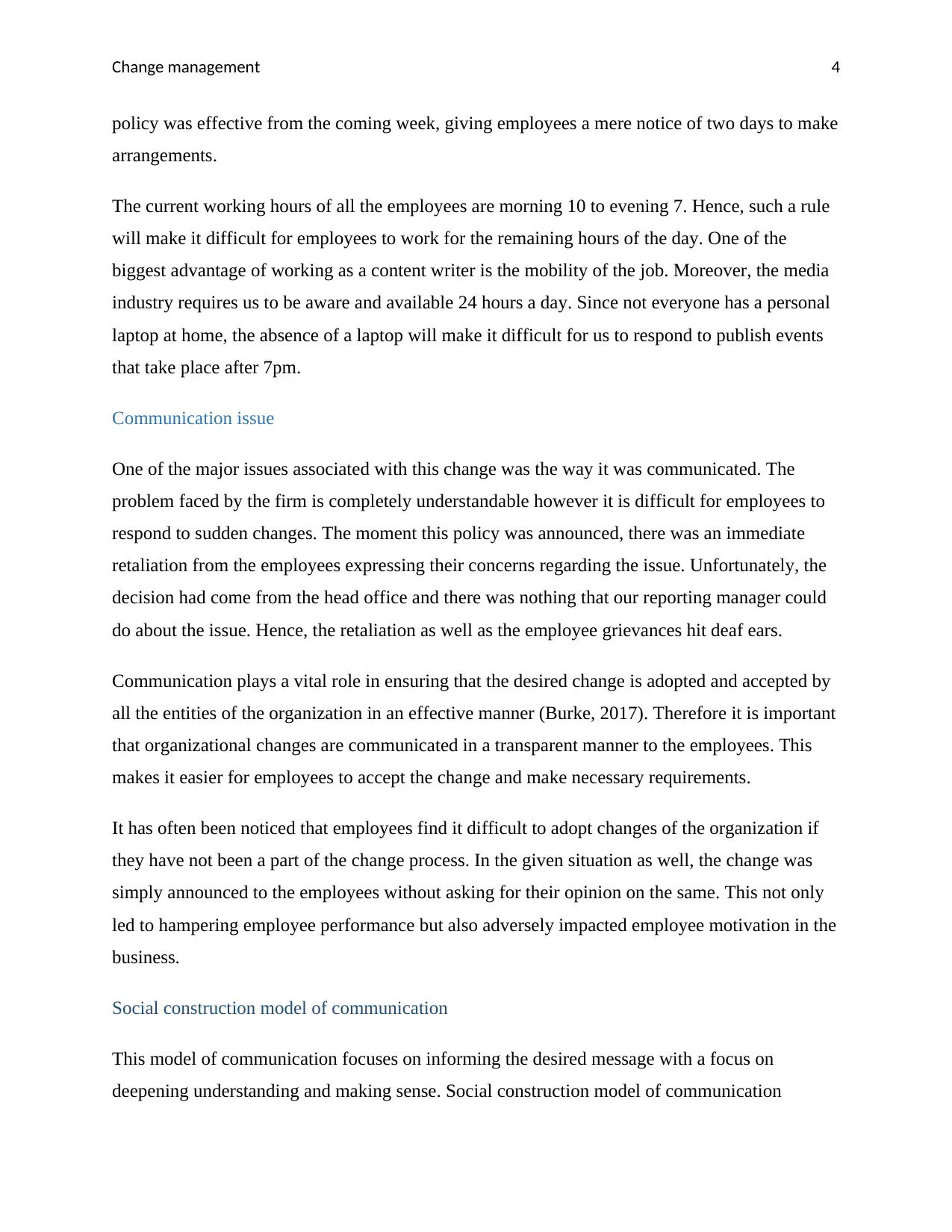
Change management 4
policy was effective from the coming week, giving employees a mere notice of two days to make
arrangements.
The current working hours of all the employees are morning 10 to evening 7. Hence, such a rule
will make it difficult for employees to work for the remaining hours of the day. One of the
biggest advantage of working as a content writer is the mobility of the job. Moreover, the media
industry requires us to be aware and available 24 hours a day. Since not everyone has a personal
laptop at home, the absence of a laptop will make it difficult for us to respond to publish events
that take place after 7pm.
Communication issue
One of the major issues associated with this change was the way it was communicated. The
problem faced by the firm is completely understandable however it is difficult for employees to
respond to sudden changes. The moment this policy was announced, there was an immediate
retaliation from the employees expressing their concerns regarding the issue. Unfortunately, the
decision had come from the head office and there was nothing that our reporting manager could
do about the issue. Hence, the retaliation as well as the employee grievances hit deaf ears.
Communication plays a vital role in ensuring that the desired change is adopted and accepted by
all the entities of the organization in an effective manner (Burke, 2017). Therefore it is important
that organizational changes are communicated in a transparent manner to the employees. This
makes it easier for employees to accept the change and make necessary requirements.
It has often been noticed that employees find it difficult to adopt changes of the organization if
they have not been a part of the change process. In the given situation as well, the change was
simply announced to the employees without asking for their opinion on the same. This not only
led to hampering employee performance but also adversely impacted employee motivation in the
business.
Social construction model of communication
This model of communication focuses on informing the desired message with a focus on
deepening understanding and making sense. Social construction model of communication
policy was effective from the coming week, giving employees a mere notice of two days to make
arrangements.
The current working hours of all the employees are morning 10 to evening 7. Hence, such a rule
will make it difficult for employees to work for the remaining hours of the day. One of the
biggest advantage of working as a content writer is the mobility of the job. Moreover, the media
industry requires us to be aware and available 24 hours a day. Since not everyone has a personal
laptop at home, the absence of a laptop will make it difficult for us to respond to publish events
that take place after 7pm.
Communication issue
One of the major issues associated with this change was the way it was communicated. The
problem faced by the firm is completely understandable however it is difficult for employees to
respond to sudden changes. The moment this policy was announced, there was an immediate
retaliation from the employees expressing their concerns regarding the issue. Unfortunately, the
decision had come from the head office and there was nothing that our reporting manager could
do about the issue. Hence, the retaliation as well as the employee grievances hit deaf ears.
Communication plays a vital role in ensuring that the desired change is adopted and accepted by
all the entities of the organization in an effective manner (Burke, 2017). Therefore it is important
that organizational changes are communicated in a transparent manner to the employees. This
makes it easier for employees to accept the change and make necessary requirements.
It has often been noticed that employees find it difficult to adopt changes of the organization if
they have not been a part of the change process. In the given situation as well, the change was
simply announced to the employees without asking for their opinion on the same. This not only
led to hampering employee performance but also adversely impacted employee motivation in the
business.
Social construction model of communication
This model of communication focuses on informing the desired message with a focus on
deepening understanding and making sense. Social construction model of communication
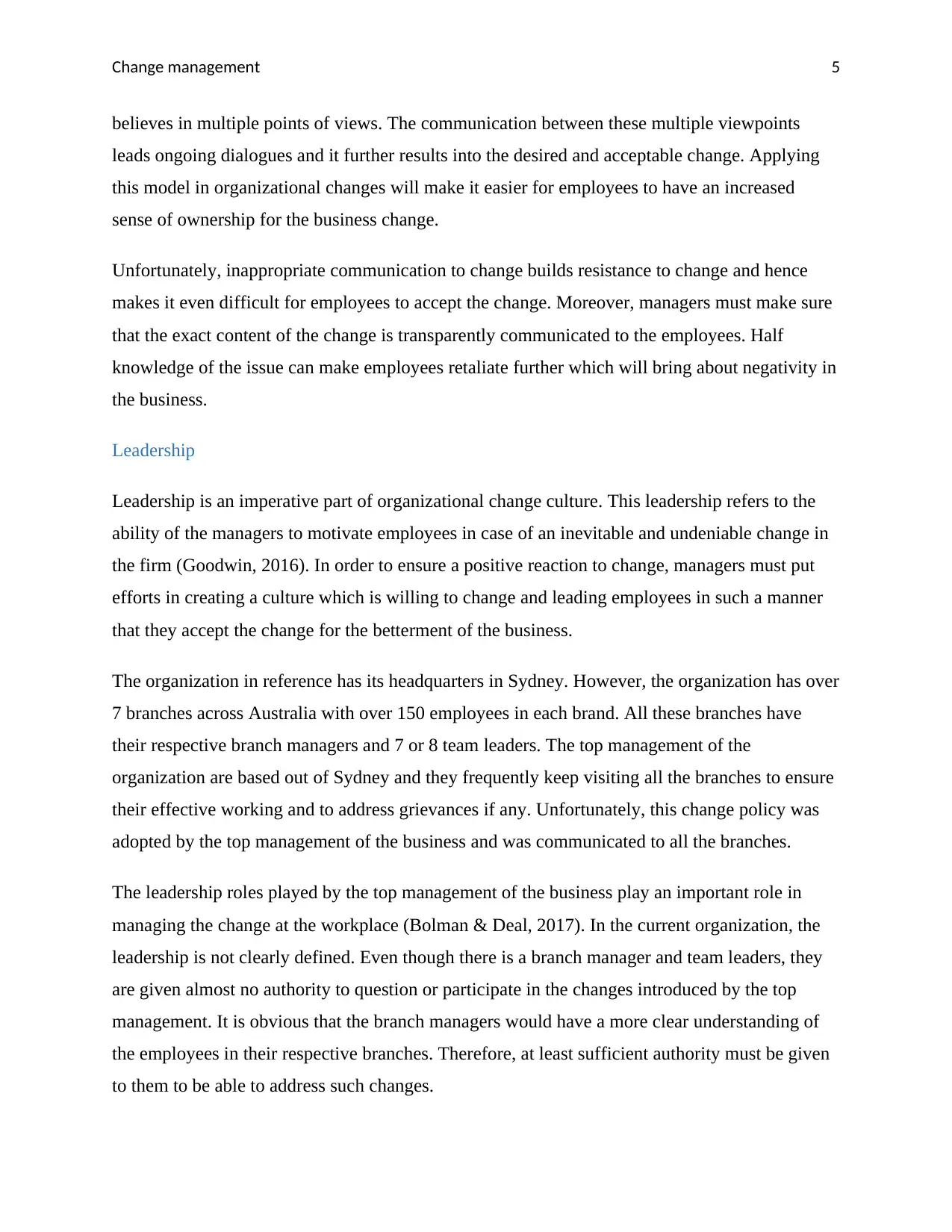
Change management 5
believes in multiple points of views. The communication between these multiple viewpoints
leads ongoing dialogues and it further results into the desired and acceptable change. Applying
this model in organizational changes will make it easier for employees to have an increased
sense of ownership for the business change.
Unfortunately, inappropriate communication to change builds resistance to change and hence
makes it even difficult for employees to accept the change. Moreover, managers must make sure
that the exact content of the change is transparently communicated to the employees. Half
knowledge of the issue can make employees retaliate further which will bring about negativity in
the business.
Leadership
Leadership is an imperative part of organizational change culture. This leadership refers to the
ability of the managers to motivate employees in case of an inevitable and undeniable change in
the firm (Goodwin, 2016). In order to ensure a positive reaction to change, managers must put
efforts in creating a culture which is willing to change and leading employees in such a manner
that they accept the change for the betterment of the business.
The organization in reference has its headquarters in Sydney. However, the organization has over
7 branches across Australia with over 150 employees in each brand. All these branches have
their respective branch managers and 7 or 8 team leaders. The top management of the
organization are based out of Sydney and they frequently keep visiting all the branches to ensure
their effective working and to address grievances if any. Unfortunately, this change policy was
adopted by the top management of the business and was communicated to all the branches.
The leadership roles played by the top management of the business play an important role in
managing the change at the workplace (Bolman & Deal, 2017). In the current organization, the
leadership is not clearly defined. Even though there is a branch manager and team leaders, they
are given almost no authority to question or participate in the changes introduced by the top
management. It is obvious that the branch managers would have a more clear understanding of
the employees in their respective branches. Therefore, at least sufficient authority must be given
to them to be able to address such changes.
believes in multiple points of views. The communication between these multiple viewpoints
leads ongoing dialogues and it further results into the desired and acceptable change. Applying
this model in organizational changes will make it easier for employees to have an increased
sense of ownership for the business change.
Unfortunately, inappropriate communication to change builds resistance to change and hence
makes it even difficult for employees to accept the change. Moreover, managers must make sure
that the exact content of the change is transparently communicated to the employees. Half
knowledge of the issue can make employees retaliate further which will bring about negativity in
the business.
Leadership
Leadership is an imperative part of organizational change culture. This leadership refers to the
ability of the managers to motivate employees in case of an inevitable and undeniable change in
the firm (Goodwin, 2016). In order to ensure a positive reaction to change, managers must put
efforts in creating a culture which is willing to change and leading employees in such a manner
that they accept the change for the betterment of the business.
The organization in reference has its headquarters in Sydney. However, the organization has over
7 branches across Australia with over 150 employees in each brand. All these branches have
their respective branch managers and 7 or 8 team leaders. The top management of the
organization are based out of Sydney and they frequently keep visiting all the branches to ensure
their effective working and to address grievances if any. Unfortunately, this change policy was
adopted by the top management of the business and was communicated to all the branches.
The leadership roles played by the top management of the business play an important role in
managing the change at the workplace (Bolman & Deal, 2017). In the current organization, the
leadership is not clearly defined. Even though there is a branch manager and team leaders, they
are given almost no authority to question or participate in the changes introduced by the top
management. It is obvious that the branch managers would have a more clear understanding of
the employees in their respective branches. Therefore, at least sufficient authority must be given
to them to be able to address such changes.
⊘ This is a preview!⊘
Do you want full access?
Subscribe today to unlock all pages.

Trusted by 1+ million students worldwide
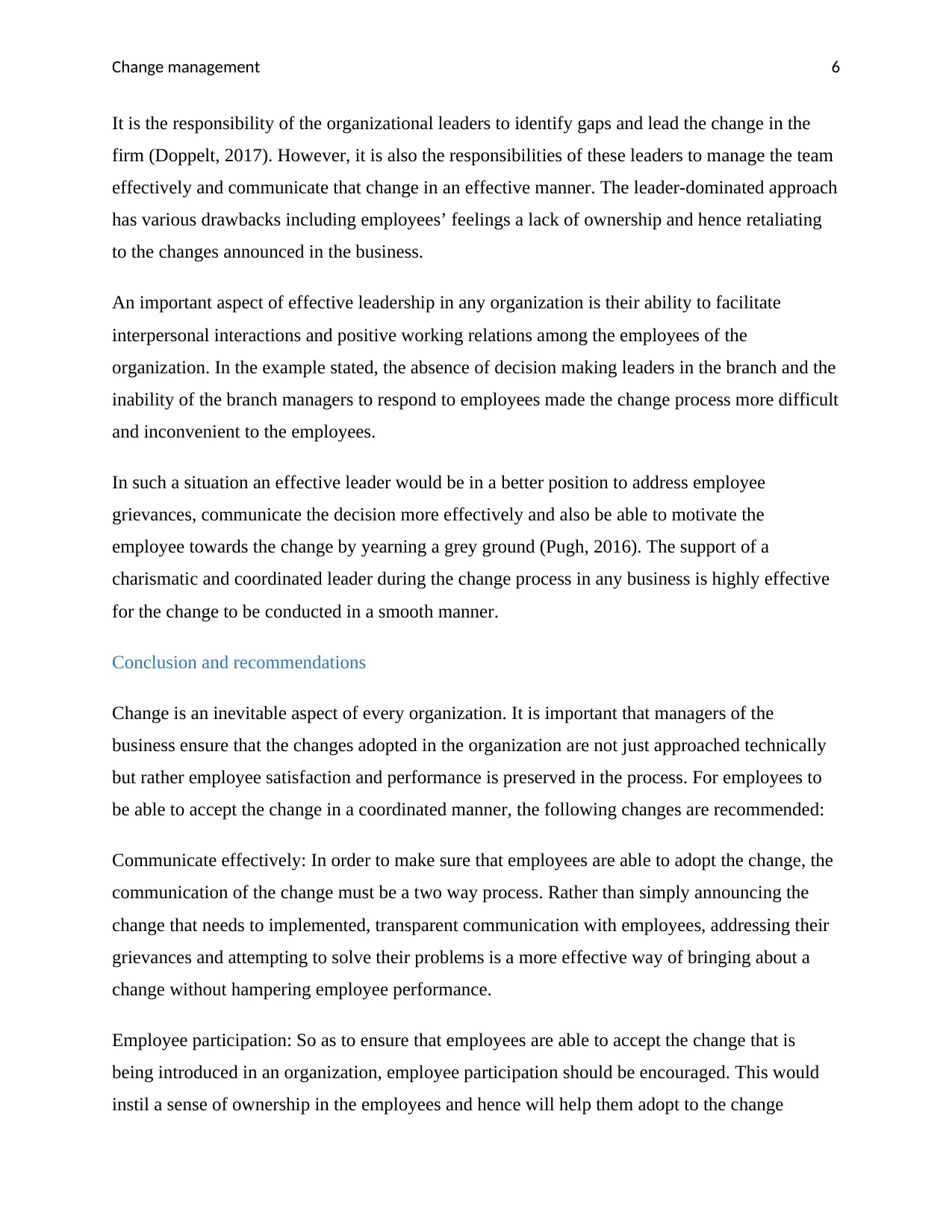
Change management 6
It is the responsibility of the organizational leaders to identify gaps and lead the change in the
firm (Doppelt, 2017). However, it is also the responsibilities of these leaders to manage the team
effectively and communicate that change in an effective manner. The leader-dominated approach
has various drawbacks including employees’ feelings a lack of ownership and hence retaliating
to the changes announced in the business.
An important aspect of effective leadership in any organization is their ability to facilitate
interpersonal interactions and positive working relations among the employees of the
organization. In the example stated, the absence of decision making leaders in the branch and the
inability of the branch managers to respond to employees made the change process more difficult
and inconvenient to the employees.
In such a situation an effective leader would be in a better position to address employee
grievances, communicate the decision more effectively and also be able to motivate the
employee towards the change by yearning a grey ground (Pugh, 2016). The support of a
charismatic and coordinated leader during the change process in any business is highly effective
for the change to be conducted in a smooth manner.
Conclusion and recommendations
Change is an inevitable aspect of every organization. It is important that managers of the
business ensure that the changes adopted in the organization are not just approached technically
but rather employee satisfaction and performance is preserved in the process. For employees to
be able to accept the change in a coordinated manner, the following changes are recommended:
Communicate effectively: In order to make sure that employees are able to adopt the change, the
communication of the change must be a two way process. Rather than simply announcing the
change that needs to implemented, transparent communication with employees, addressing their
grievances and attempting to solve their problems is a more effective way of bringing about a
change without hampering employee performance.
Employee participation: So as to ensure that employees are able to accept the change that is
being introduced in an organization, employee participation should be encouraged. This would
instil a sense of ownership in the employees and hence will help them adopt to the change
It is the responsibility of the organizational leaders to identify gaps and lead the change in the
firm (Doppelt, 2017). However, it is also the responsibilities of these leaders to manage the team
effectively and communicate that change in an effective manner. The leader-dominated approach
has various drawbacks including employees’ feelings a lack of ownership and hence retaliating
to the changes announced in the business.
An important aspect of effective leadership in any organization is their ability to facilitate
interpersonal interactions and positive working relations among the employees of the
organization. In the example stated, the absence of decision making leaders in the branch and the
inability of the branch managers to respond to employees made the change process more difficult
and inconvenient to the employees.
In such a situation an effective leader would be in a better position to address employee
grievances, communicate the decision more effectively and also be able to motivate the
employee towards the change by yearning a grey ground (Pugh, 2016). The support of a
charismatic and coordinated leader during the change process in any business is highly effective
for the change to be conducted in a smooth manner.
Conclusion and recommendations
Change is an inevitable aspect of every organization. It is important that managers of the
business ensure that the changes adopted in the organization are not just approached technically
but rather employee satisfaction and performance is preserved in the process. For employees to
be able to accept the change in a coordinated manner, the following changes are recommended:
Communicate effectively: In order to make sure that employees are able to adopt the change, the
communication of the change must be a two way process. Rather than simply announcing the
change that needs to implemented, transparent communication with employees, addressing their
grievances and attempting to solve their problems is a more effective way of bringing about a
change without hampering employee performance.
Employee participation: So as to ensure that employees are able to accept the change that is
being introduced in an organization, employee participation should be encouraged. This would
instil a sense of ownership in the employees and hence will help them adopt to the change
Paraphrase This Document
Need a fresh take? Get an instant paraphrase of this document with our AI Paraphraser
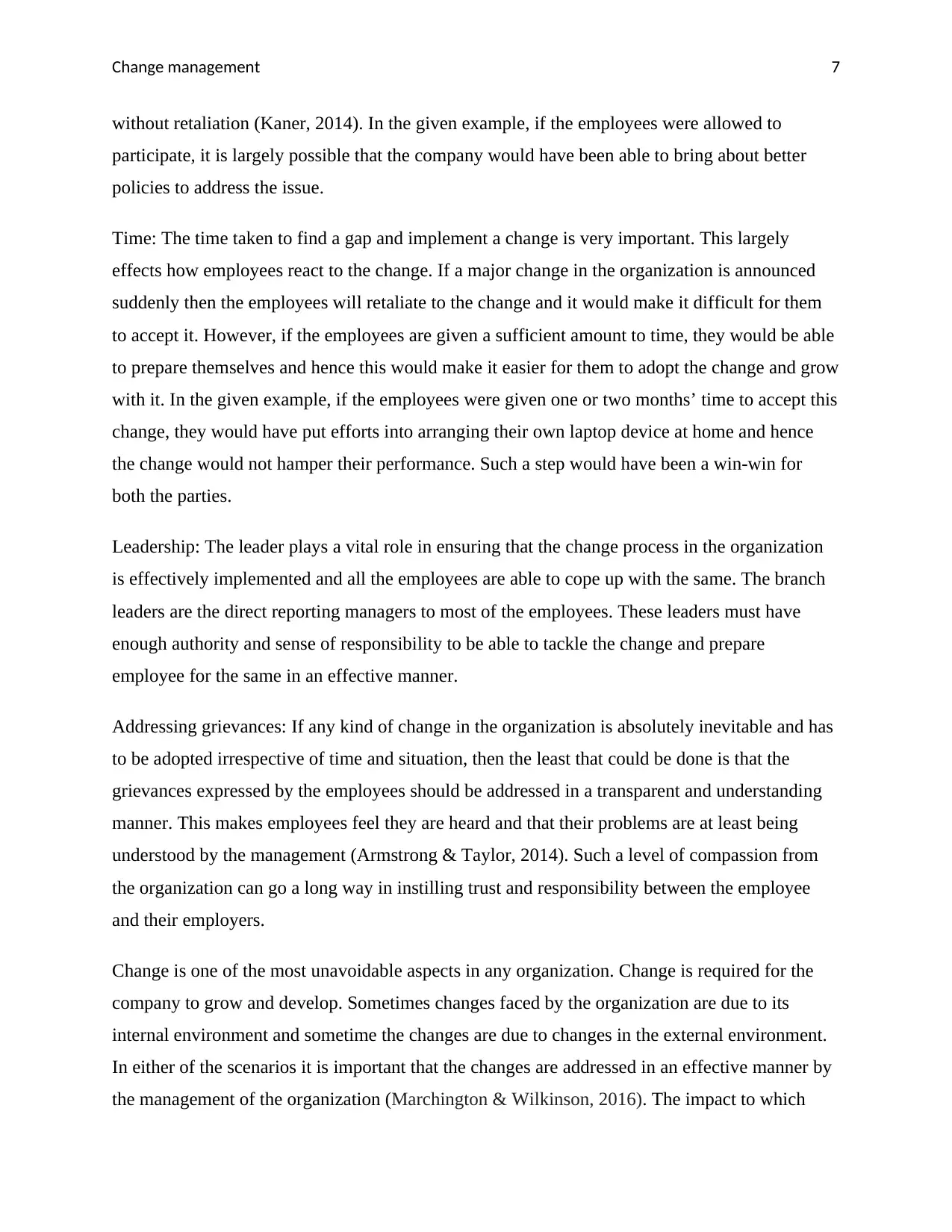
Change management 7
without retaliation (Kaner, 2014). In the given example, if the employees were allowed to
participate, it is largely possible that the company would have been able to bring about better
policies to address the issue.
Time: The time taken to find a gap and implement a change is very important. This largely
effects how employees react to the change. If a major change in the organization is announced
suddenly then the employees will retaliate to the change and it would make it difficult for them
to accept it. However, if the employees are given a sufficient amount to time, they would be able
to prepare themselves and hence this would make it easier for them to adopt the change and grow
with it. In the given example, if the employees were given one or two months’ time to accept this
change, they would have put efforts into arranging their own laptop device at home and hence
the change would not hamper their performance. Such a step would have been a win-win for
both the parties.
Leadership: The leader plays a vital role in ensuring that the change process in the organization
is effectively implemented and all the employees are able to cope up with the same. The branch
leaders are the direct reporting managers to most of the employees. These leaders must have
enough authority and sense of responsibility to be able to tackle the change and prepare
employee for the same in an effective manner.
Addressing grievances: If any kind of change in the organization is absolutely inevitable and has
to be adopted irrespective of time and situation, then the least that could be done is that the
grievances expressed by the employees should be addressed in a transparent and understanding
manner. This makes employees feel they are heard and that their problems are at least being
understood by the management (Armstrong & Taylor, 2014). Such a level of compassion from
the organization can go a long way in instilling trust and responsibility between the employee
and their employers.
Change is one of the most unavoidable aspects in any organization. Change is required for the
company to grow and develop. Sometimes changes faced by the organization are due to its
internal environment and sometime the changes are due to changes in the external environment.
In either of the scenarios it is important that the changes are addressed in an effective manner by
the management of the organization (Marchington & Wilkinson, 2016). The impact to which
without retaliation (Kaner, 2014). In the given example, if the employees were allowed to
participate, it is largely possible that the company would have been able to bring about better
policies to address the issue.
Time: The time taken to find a gap and implement a change is very important. This largely
effects how employees react to the change. If a major change in the organization is announced
suddenly then the employees will retaliate to the change and it would make it difficult for them
to accept it. However, if the employees are given a sufficient amount to time, they would be able
to prepare themselves and hence this would make it easier for them to adopt the change and grow
with it. In the given example, if the employees were given one or two months’ time to accept this
change, they would have put efforts into arranging their own laptop device at home and hence
the change would not hamper their performance. Such a step would have been a win-win for
both the parties.
Leadership: The leader plays a vital role in ensuring that the change process in the organization
is effectively implemented and all the employees are able to cope up with the same. The branch
leaders are the direct reporting managers to most of the employees. These leaders must have
enough authority and sense of responsibility to be able to tackle the change and prepare
employee for the same in an effective manner.
Addressing grievances: If any kind of change in the organization is absolutely inevitable and has
to be adopted irrespective of time and situation, then the least that could be done is that the
grievances expressed by the employees should be addressed in a transparent and understanding
manner. This makes employees feel they are heard and that their problems are at least being
understood by the management (Armstrong & Taylor, 2014). Such a level of compassion from
the organization can go a long way in instilling trust and responsibility between the employee
and their employers.
Change is one of the most unavoidable aspects in any organization. Change is required for the
company to grow and develop. Sometimes changes faced by the organization are due to its
internal environment and sometime the changes are due to changes in the external environment.
In either of the scenarios it is important that the changes are addressed in an effective manner by
the management of the organization (Marchington & Wilkinson, 2016). The impact to which
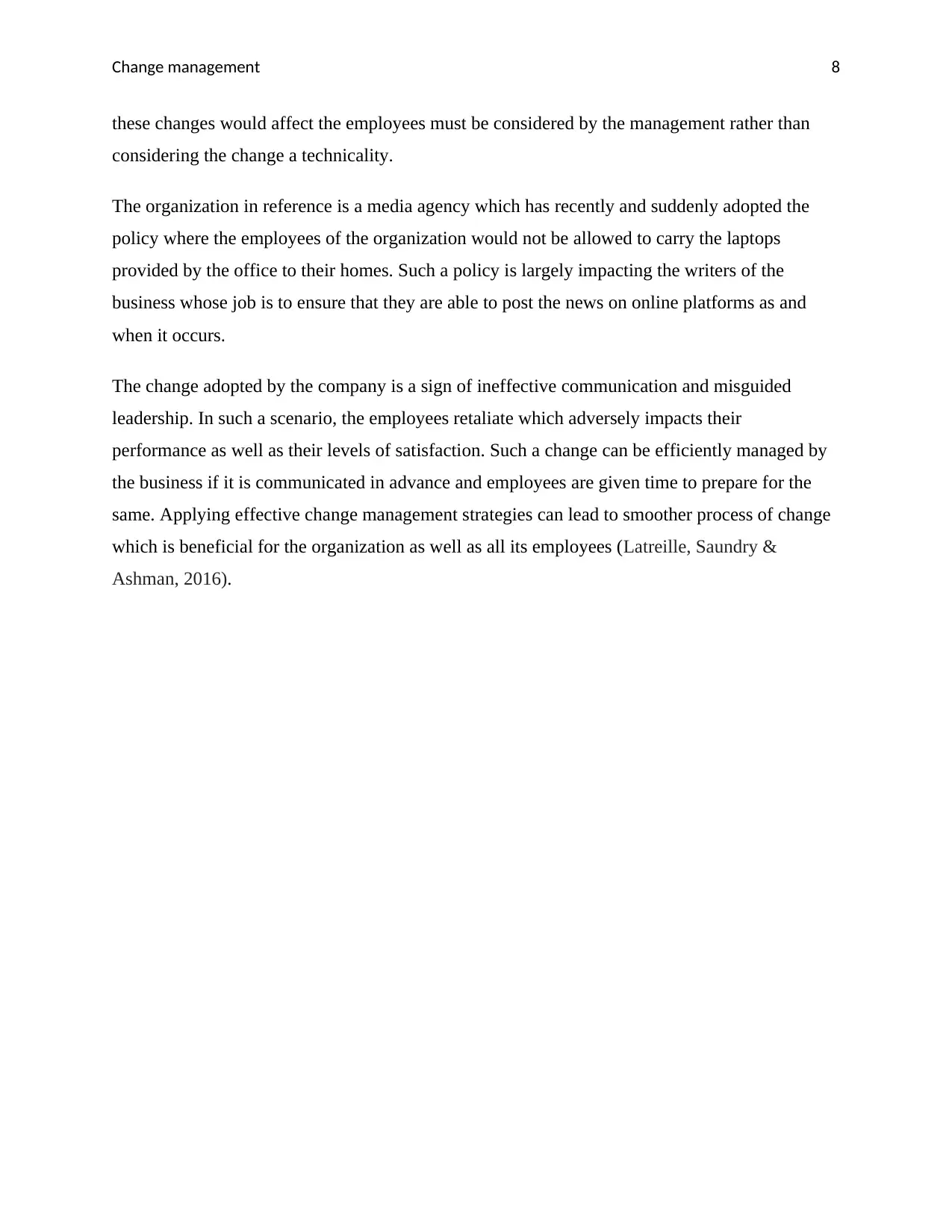
Change management 8
these changes would affect the employees must be considered by the management rather than
considering the change a technicality.
The organization in reference is a media agency which has recently and suddenly adopted the
policy where the employees of the organization would not be allowed to carry the laptops
provided by the office to their homes. Such a policy is largely impacting the writers of the
business whose job is to ensure that they are able to post the news on online platforms as and
when it occurs.
The change adopted by the company is a sign of ineffective communication and misguided
leadership. In such a scenario, the employees retaliate which adversely impacts their
performance as well as their levels of satisfaction. Such a change can be efficiently managed by
the business if it is communicated in advance and employees are given time to prepare for the
same. Applying effective change management strategies can lead to smoother process of change
which is beneficial for the organization as well as all its employees (Latreille, Saundry &
Ashman, 2016).
these changes would affect the employees must be considered by the management rather than
considering the change a technicality.
The organization in reference is a media agency which has recently and suddenly adopted the
policy where the employees of the organization would not be allowed to carry the laptops
provided by the office to their homes. Such a policy is largely impacting the writers of the
business whose job is to ensure that they are able to post the news on online platforms as and
when it occurs.
The change adopted by the company is a sign of ineffective communication and misguided
leadership. In such a scenario, the employees retaliate which adversely impacts their
performance as well as their levels of satisfaction. Such a change can be efficiently managed by
the business if it is communicated in advance and employees are given time to prepare for the
same. Applying effective change management strategies can lead to smoother process of change
which is beneficial for the organization as well as all its employees (Latreille, Saundry &
Ashman, 2016).
⊘ This is a preview!⊘
Do you want full access?
Subscribe today to unlock all pages.

Trusted by 1+ million students worldwide
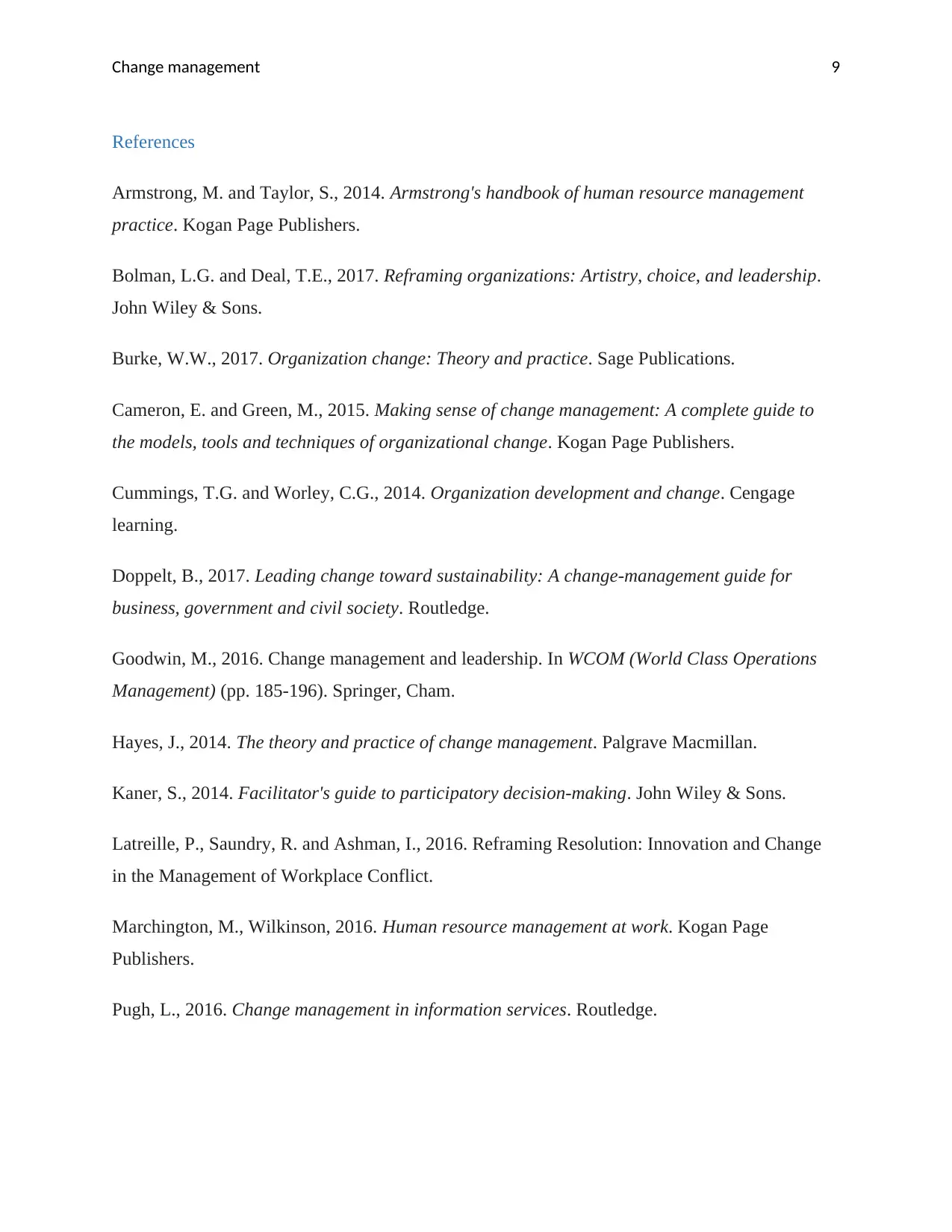
Change management 9
References
Armstrong, M. and Taylor, S., 2014. Armstrong's handbook of human resource management
practice. Kogan Page Publishers.
Bolman, L.G. and Deal, T.E., 2017. Reframing organizations: Artistry, choice, and leadership.
John Wiley & Sons.
Burke, W.W., 2017. Organization change: Theory and practice. Sage Publications.
Cameron, E. and Green, M., 2015. Making sense of change management: A complete guide to
the models, tools and techniques of organizational change. Kogan Page Publishers.
Cummings, T.G. and Worley, C.G., 2014. Organization development and change. Cengage
learning.
Doppelt, B., 2017. Leading change toward sustainability: A change-management guide for
business, government and civil society. Routledge.
Goodwin, M., 2016. Change management and leadership. In WCOM (World Class Operations
Management) (pp. 185-196). Springer, Cham.
Hayes, J., 2014. The theory and practice of change management. Palgrave Macmillan.
Kaner, S., 2014. Facilitator's guide to participatory decision-making. John Wiley & Sons.
Latreille, P., Saundry, R. and Ashman, I., 2016. Reframing Resolution: Innovation and Change
in the Management of Workplace Conflict.
Marchington, M., Wilkinson, 2016. Human resource management at work. Kogan Page
Publishers.
Pugh, L., 2016. Change management in information services. Routledge.
References
Armstrong, M. and Taylor, S., 2014. Armstrong's handbook of human resource management
practice. Kogan Page Publishers.
Bolman, L.G. and Deal, T.E., 2017. Reframing organizations: Artistry, choice, and leadership.
John Wiley & Sons.
Burke, W.W., 2017. Organization change: Theory and practice. Sage Publications.
Cameron, E. and Green, M., 2015. Making sense of change management: A complete guide to
the models, tools and techniques of organizational change. Kogan Page Publishers.
Cummings, T.G. and Worley, C.G., 2014. Organization development and change. Cengage
learning.
Doppelt, B., 2017. Leading change toward sustainability: A change-management guide for
business, government and civil society. Routledge.
Goodwin, M., 2016. Change management and leadership. In WCOM (World Class Operations
Management) (pp. 185-196). Springer, Cham.
Hayes, J., 2014. The theory and practice of change management. Palgrave Macmillan.
Kaner, S., 2014. Facilitator's guide to participatory decision-making. John Wiley & Sons.
Latreille, P., Saundry, R. and Ashman, I., 2016. Reframing Resolution: Innovation and Change
in the Management of Workplace Conflict.
Marchington, M., Wilkinson, 2016. Human resource management at work. Kogan Page
Publishers.
Pugh, L., 2016. Change management in information services. Routledge.
1 out of 10
Related Documents
Your All-in-One AI-Powered Toolkit for Academic Success.
+13062052269
info@desklib.com
Available 24*7 on WhatsApp / Email
![[object Object]](/_next/static/media/star-bottom.7253800d.svg)
Unlock your academic potential
Copyright © 2020–2025 A2Z Services. All Rights Reserved. Developed and managed by ZUCOL.





